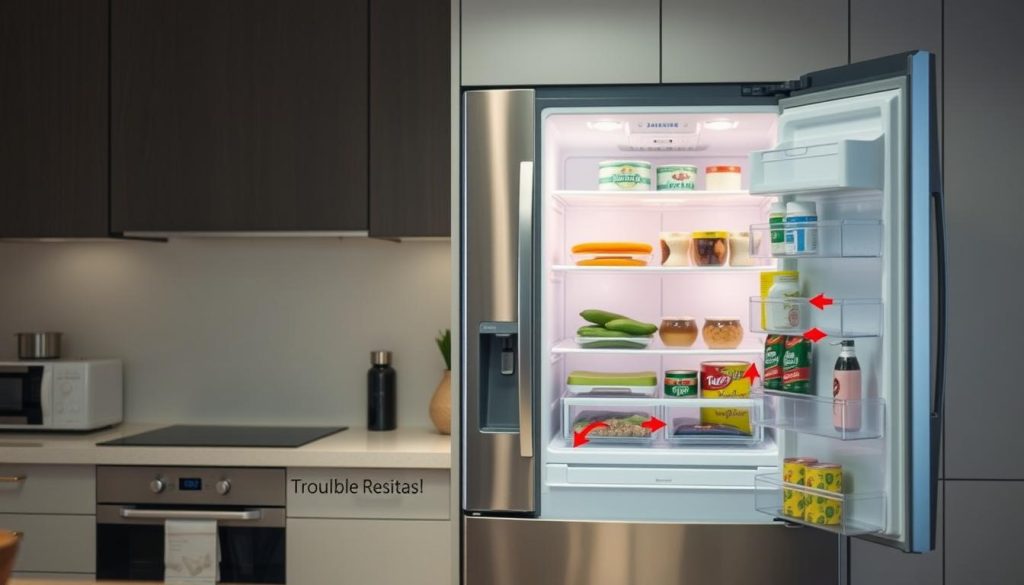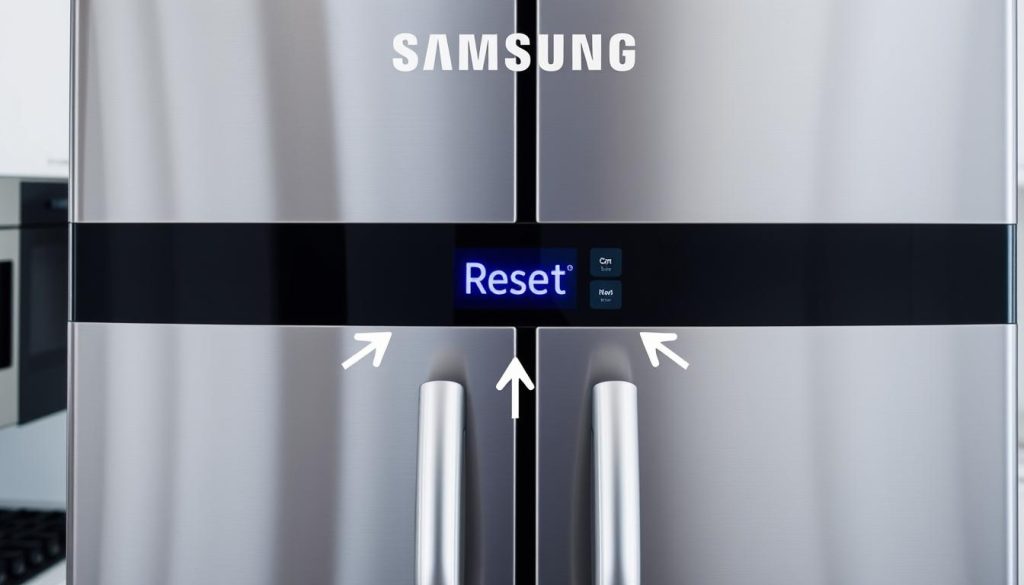Keeping your Samsung fridge in top shape is key. Sometimes, a reset can fix many issues fast. If your fridge’s temperature is off or it shows error codes, a reset can help. Modern fridges have complex systems. A reset can fix technical problems without needing a pro. This guide will show you how to reset your Samsung fridge in three easy steps. It will help your fridge work better and keep your food fresh.
Appliances can sometimes have small problems. Knowing how to reset your fridge helps keep it working well. It might even save you from expensive repairs. With the right steps, you can fix many fridge issues quickly.
Understanding Why Your Samsung Fridge Needs a Reset
Samsung refrigerator repair often involves understanding when and why a reset is crucial for your appliance’s performance. Modern refrigerators are complex electronic systems. They occasionally require troubleshooting to maintain optimal functionality.

Common Issues Requiring a Reset
Samsung fridge troubleshooting reveals several key scenarios where a reset becomes necessary:
- Temperature inconsistencies
- Unexpected error codes on display panel
- Malfunctioning ice maker or water dispenser
- Electronic control panel unresponsiveness
- Intermittent cooling performance
Signs Your Refrigerator Needs Resetting
Recognizing when your Samsung refrigerator requires intervention can prevent major mechanical issues. Watch for these critical indicators:
- Unusual noises during operation
- Frost buildup in unexpected areas
- Sudden increase in energy consumption
- Persistent warning lights on control panel
Benefits of Proper Reset Procedures
Implementing a strategic reset offers multiple advantages for your Samsung refrigerator:
| Reset Benefit | Impact on Refrigerator |
|---|---|
| System Recalibration | Restores default settings and resolves minor glitches |
| Performance Optimization | Improves overall cooling efficiency |
| Error Code Elimination | Clears unexplained electronic warnings |
| Energy Efficiency | Reduces unnecessary power consumption |
Understanding these reset dynamics empowers homeowners to maintain their Samsung refrigerator’s peak performance. This is through proactive samsung fridge troubleshooting techniques.
Essential Safety Precautions Before Resetting
Resetting your Samsung fridge needs careful steps and safety first. Before you start, make sure you’re safe and your fridge is too.

First, know the risks of working with electrical appliances. Samsung fridges have complex systems that need careful handling.
- Unplug the refrigerator from the electrical outlet
- Remove all perishable food items
- Clear the surrounding area of obstacles
- Wear protective rubber-soled shoes
Electrical safety is key. Make sure your hands are dry and stay away from water. This way, you avoid risks when resetting your fridge.
| Safety Action | Purpose |
|---|---|
| Disconnect Power | Prevent electrical shock |
| Remove Food | Protect perishables during reset |
| Check Electrical Cord | Ensure no damage before reset |
Experts say to use a voltage tester and check the outlet first. Knowing these steps helps you reset your Samsung fridge safely and easily.
Reset Samsung Fridge: Step-by-Step Guide
Resetting your Samsung fridge can fix many issues and make it work better. It might seem hard, but you can do it easily. You can reset the control panel or do a factory reset.

It’s important to know that different Samsung fridges have different reset steps. Always check your fridge’s manual for the right way to reset it.
Power Cycling Method
Power cycling is a simple reset method for most Samsung fridges. Here’s how to do it:
- Unplug the fridge from the outlet
- Wait about 5 minutes
- Plug it back in
- Let it start up and adjust again
Control Panel Reset Process
For a specific reset of the control panel, follow these steps:
- Find the control panel on your fridge
- Press and hold the reset button (it varies by model)
- Wait for the display to reset or show a message
Force Reset Instructions
A force reset can solve serious issues with your fridge:
- Press the “Power Freeze” and “Power Cool” buttons together
- Hold for 10 seconds until you hear a beep
- Release the buttons and wait for it to reset
Remember, a factory reset should be a last choice. If problems keep coming back, call Samsung support or a pro.
Troubleshooting Common Reset Problems
Fixing Samsung refrigerators can be tough when resets don’t work. Knowing common problems helps homeowners fix issues without calling an expensive repair service.
Fixing Samsung fridges needs careful steps. Some fridges might not react right away to reset steps. This can be frustrating for users.
- Check power connections thoroughly
- Verify electrical outlet functionality
- Inspect circuit breaker status
- Examine control panel connections
Deeper electrical or mechanical problems might cause reset issues. Finding the real cause stops repeated resets that could harm electronics.
| Problem | Potential Cause | Recommended Action |
|---|---|---|
| No Response After Reset | Faulty Control Board | Professional Diagnostic Check |
| Intermittent Cooling | Sensor Malfunction | Recalibrate Temperature Sensors |
| Error Codes Persist | Software Glitch | Complete Power Cycle |
Advanced repair for Samsung fridges means understanding error codes. Some codes need special reset steps that are different from usual ones.
- Document error codes precisely
- Consult Samsung support documentation
- Follow manufacturer-recommended troubleshooting steps
If troubleshooting steps don’t work, you might need a pro. Trying hard repairs yourself could also void your warranty.
Samsung Fridge Control Panel Functions
Modern Samsung refrigerators have advanced control panels. They offer convenience and precise temperature control. Knowing how to use these panels is key to getting the most out of your fridge.
The control panel is the heart of your fridge. It lets you adjust settings and keep an eye on your fridge’s performance. It’s important to understand how to use it for a successful reset.
Display Panel Features
Samsung fridges have digital displays that show real-time info. These displays include:
- Temperature readings for both compartments
- Energy consumption indicators
- Filter replacement alerts
- Door open warnings
Temperature Control Settings
Keeping food fresh is all about the right temperature. Samsung’s panels let you adjust the temperature:
| Compartment | Temperature Range | Recommended Setting |
|---|---|---|
| Refrigerator | 34-40°F | 38°F |
| Freezer | 0-5°F | 0°F |
Smart Features Overview
Recent Samsung fridges come with smart tech. This lets you:
- Check internal temperatures from afar
- Get reminders for maintenance
- Change settings with your phone
- Use special cooling modes
Understanding your fridge’s control panel is crucial. It helps you manage your fridge well and ensures it works its best after a reset.
Maintaining Your Samsung Refrigerator After Reset
After resetting your Samsung Fridge ice maker, it’s important to keep it in good shape. Your fridge needs regular care to work well and avoid problems later.
There are a few important steps to keep your Samsung fridge running smoothly:
- Clean the interior surfaces monthly with mild cleaning solutions
- Check and replace the samsung fridge water filter every 6 months
- Inspect door seals for signs of wear or damage
- Maintain consistent temperature settings
- Clear dust from condenser coils annually
Keeping the right temperature is key for your fridge. Set it between 37-40°F and the freezer at 0°F for best food storage. Always check the ice maker and water filter during your routine checks.
Sticking to a regular maintenance schedule is crucial. Keeping an eye on your samsung fridge water filter reset helps ensure clean water and ice. Simple steps can make your fridge last longer and work better.
- Perform visual inspections every 30 days
- Listen for unusual sounds
- Check water and ice quality
- Clean removable compartments
By following these tips, you’ll keep your fridge in top shape. This way, you’ll enjoy reliable cooling for many years.
When to Contact Professional Service
Dealing with samsung refrigerator repair can be tough for homeowners. It’s important to know when to call a pro to keep your fridge running well.
Understanding Warranty Coverage
Samsung has a great warranty for refrigerators. It usually covers:
- Manufacturing defects
- Electrical system failures
- Compressor malfunctions
- Parts replacement within specific timeframes
Critical Signs Requiring Professional Samsung Fridge Troubleshooting
Some fridge problems need a pro’s touch. Look out for these signs that mean you should get help:
- Persistent cooling problems despite reset attempts
- Unusual grinding or loud mechanical noises
- Electronic control panel displaying multiple error codes
- Significant frost buildup inside the refrigerator
- Water leakage from multiple areas
Professional Repair Recommendations
Certified Samsung technicians offer top-notch diagnostics and repairs. They make sure your fridge gets the best care, avoiding long-term damage and keeping it efficient.
Always check your warranty before getting repairs. Some problems might be covered, saving you a lot of money on samsung refrigerator repair.
Conclusion
Resetting a Samsung refrigerator is easier than you think. Knowing the right steps can fix small problems and keep your fridge working well. We’ve shown you simple ways to solve common issues.
Resetting your fridge needs patience and following the manufacturer’s advice. Doing it right can avoid damage and make your fridge last longer. Each reset method tackles different problems, from power cycling to control panel tweaks.
Keeping your Samsung fridge in top shape is important. Always put safety first, check the manual, and get help if problems persist. With the right skills, you can keep your fridge cool and efficient for many years.
Preventing problems is the best approach. Clean your fridge regularly, use it wisely, and watch for odd behavior. This way, you’ll need to reset it less often and keep it running smoothly.
1 thought on “How to Reset Your Samsung Fridge in 3 Easy Steps”
Comments are closed.